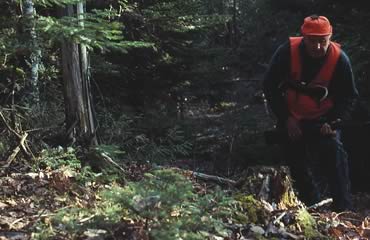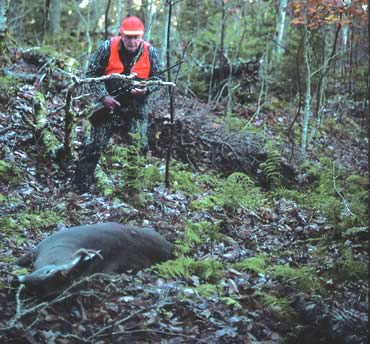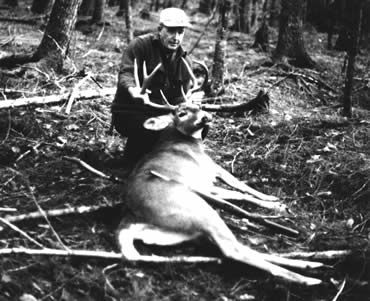By Joel S. Fawcett
Be prepared to get cut and dirty if you want to go where the giants roam.
It was the second week of the Maine firearms deer season, and I hadn’t visited the deer woods because of a very successful fly fishing foray to Ontario. I was antsy to go hunting, but I first stopped by the Pine Tree Store — it’s the village’s only emporium, and also a deer registration station.
I took a seat on the liar’s bench to check on the first eight days’ deer harvest. Opening day, I was told, the hunting had been top-notch. Day two was pretty good, too, but since then the deer — a common sight around the village during summer and early fall — had vanished.
I knew exactly where I would be hunting the following day.
With a streak of pink showing along the eastern horizon to start the day, my wife, Lillian, and I drove down the Little River Road about 4 miles from our home in Grand Lake Stream in northeastern Maine. We stopped near the mouth of an ancient tote road.
“I’ll see you here at dark,” I reminded my spouse as she gave me a good-luck kiss before heading back home.
The Little River Road is a hard-hunted woods byway, so once Lillian left, I hiked about three quarters of a mile back into the woods via the primitive tote road. My destination? The edge of a cedar swamp.
My arrival at the swamp coincided with the onset of legal shooting light. Consequently, I jacked a 7mm-08 shell into the chamber of my Remington Model 7, checked the safety and squirted some cover scent on my boot pads. Then, I quietly picked my way through the dense jungle of conifer thickets and willywags that bordered the swamp.
 I came upon more blackgrowth and puckerbrush thickets, but these were more navigable, harboring a network of worn game trails lined with rubs and several recently worked scrapes.
I came upon more blackgrowth and puckerbrush thickets, but these were more navigable, harboring a network of worn game trails lined with rubs and several recently worked scrapes.
I was in buck nirvana, but because of the tough access, I had no concern about any other orange suits invading my haven. The cedar swamp was also the likely destination of many of the bucks that road hunters had spooked.
I hunted throughout the morning without incident, but about an hour after lunch while perched on a blow-down, I was startled by the sound of a dry stick popping a short distance away. An instant later, I caught a glimpse of gray hide and heavy antlers coming my way.
A dandy 8-pointer emerged, and I slowly shouldered my rifle, released the safety and waited. The brawny buck stepped into an open glen, and I touched off a shot.
I was sure I’d hit the brute, but he tore away as if unscathed. Instead of fleeing deep into the swamp, the big bruiser circled and headed back in my direction. I jacked another round into the chamber but had to jump out of the way to avoid being stampeded. After almost knocking me down, the buck staggered and collapsed about 5 feet from where I stood.
Wow!
It wasn’t the biggest buck I had ever shot, but it certainly was one of the most memorable.
It’s no secret that a majority of the season’s deer harvest occurs during the first day or two of the firearms season. But when the guns start popping and an army of orange suits invades the deer woods, whitetails go on red alert. When this occurs, the big bucks you observed throughout the late summer and early fall mysteriously disappear.
Many believe these deer have migrated out of the area, but I don’t think so. Home territory is very important to a white-tailed buck; and despite a heap of hunters wandering about their terrain, bucks are reluctant to leave their home ranges. So where do they go?
Actually, they haven’t gone anywhere. They’ve merely retreated into the thickest jungle of nasty cover with an adequate escape route within their home territory — a place most hunters refuse to go. Once there, they hunker down and are not likely to venture out except under the cover of darkness.
 Where I hunt in the big woods of northern New England, this translates into cedar swamps, the belt of cover that borders the banks of back-country rivers and streams, or lowland blackgrowth knolls. Each of these lowland areas features a similar habitat heavy with spruce, hemlock, fir and puckerbrush and an ample number of blow-downs. These areas are best hunted by still-hunting and/or by finding some ground-level cover where you can wait out a buck.
Where I hunt in the big woods of northern New England, this translates into cedar swamps, the belt of cover that borders the banks of back-country rivers and streams, or lowland blackgrowth knolls. Each of these lowland areas features a similar habitat heavy with spruce, hemlock, fir and puckerbrush and an ample number of blow-downs. These areas are best hunted by still-hunting and/or by finding some ground-level cover where you can wait out a buck.
Many hunters are intimidated by what appears to be an impenetrable maze of thicket, and most take one look at this habitat and opt to hunt the more open country. Others notice the lack of treestand-suitable trees and opt for greener pastures. And I’m glad they do.
Richard Arsenalt, the founder and recently retired director of the Maine Antler & Skull Trophy Club, told me that practically all of Maine’s record-book whitetail bucks were harvested out of lowland locations. As a registered Maine guide and tent-camp outfitter for 18 deer seasons, many of the hunters I’ve guided lacked the patience and concentration to successfully skulk about in the blackgrowth hideouts. They move through the cover at a much-too-rapid pace and alert bucks to their approach.
Typically, I cover no more than a mile and a half of fertile whitetail habitat in a full day’s hunt. I spend at least 90 percent of my time in the deer woods listening and peering. My usual still-hunting pace is to sneak through the woods in ghost-like silence, taking one step and meticulously inspecting the habitat in all directions. Then I kneel and carefully scrutinize the surrounding habitat again. Only then is it time to take another step. Try repeating that process for an entire day.
Avoid brushing against anything that will make a noise. If you slip and crack a twig, blow on your grunt call a few times to put the deer at ease. Also try to not spook other wildlife. A partridge thundering out from underfoot, the squeak of a startled chipmunk, the screech of a blue jay or the alarm signal of a squirrel will put a buck on alert.
Wear quiet clothing. I employ the layering system and presently wear a Browning Hell’s Canyon fleece suit that’s quiet, windproof, weather resistant and scent-protected.
It’s also important to travel light. I carry only must-have items (compass, topo map, 8x monocular, knife, flashlight, deer drag, grunt call, cover scent and my lunch).
Avoid any unnecessary motion. It’s difficult for a whitetail to pick out a hunter who moves slowly and judiciously, but one who frequently looks at his watch, pulls out a handkerchief, shifts his rifle from one hand to the other or scratches an itch will be quickly identified.
 To hunt the thickets, your rifle should be short and light, no more than 7 pounds with a low-power scope. Make sure you’re comfortable enough with the gun to make a quick but accurate shot.
To hunt the thickets, your rifle should be short and light, no more than 7 pounds with a low-power scope. Make sure you’re comfortable enough with the gun to make a quick but accurate shot.
Some still-hunters I know like open sights, but a low-power scope is far superior for zeroing in on a big buck in the thick stuff, particularly under low light or when it’s necessary to squeeze a shot through a narrow opening.
Further, it takes practice to quickly recognize a deer in the thicket. Many hunters make the mistake of looking for the whole deer. You never get to see the entire animal when hunting the thickets; it will almost always be at least partially screened. The trick is to look for pieces: a glistening eye, the flick of an ear or tail, a leg or a piece of antler.
A good place to begin is to look for horizontal lines. It might only be a log, but you might be eyeballing the back or belly line of the buck of your dreams. Also study any odd stumps, rocks, logs, clumps of brush, tree branches, pieces of birch bark, etc., very closely. They probably are what they appear to be, but a second look might reveal a brawny buck.
To be a successful deer hunter, you must learn to think like a deer. To do that, you need a thorough knowledge of the whitetail’s daily routine. If you’re completely satisfied with your present hunting strategies, that’s fine. But if you’ve become a collector of unused deer tags, it’s time to try still-hunting cedar swamps, river banks, blackgrowth knolls and other jungles of nasty cover. Hunting where nobody else will go has kept my freezer full of venison for the past 35-plus deer seasons and counting.
Read Recent Articles:
• Lost and Found: How a top-10 Pa. buck almost never made it to the hunter’s wall.
• Fetching Sheds: Antler hunting is more fun with man’s best friend.
• Bowhunting Mini-Lessons: No matter how many years you hunt with a bow, there’s always something new to learn.
This article was published in the October 2008 edition of Buckmasters Whitetail Magazine. Join today to have Buckmasters delivered to your home.